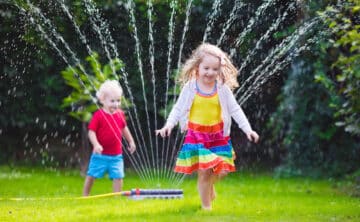Benefits of a Healthy Lawn to the Environment & Your Life
With all of the debate about lawns you may wonder if maintaining your grass is good for the environment. Good news–you can enjoy the benefits of a maintained lawn and know that your efforts are making a positive environmental impact! Read more about how a healthy lawn benefits the environment. Additionally, follow the tips compiled by our lawn care experts on how best to increase the sustainability of your lawn.
What are the environmental benefits of my Minnesota lawn?
From your own backyard to greenspaces in cities, parks, and recreational areas, turfgrass is everywhere. While all of the mowing and maintenance to keep a lawn healthy may have you questioning the environmental impact, a healthy lawn has many positive qualities. Below are the top six benefits of your lawn:

- Creates oxygen through photosynthesis. Like all green plants, your lawn uses carbon dioxide (CO2) for photosynthesis and releases oxygen. Oxygen is essential for human life as well as reduces CO2 which leads to elevated air temperatures and other environmental dangers.
- Provides habitat for wildlife. Healthy turf is a source of worms, beetles, and other insects that birds feed on. Additionally, tall grass creates shelter for many other small species of wildlife, including frogs and mice, which are a food source of larger birds.
- Prevents erosion. When there is heavy rainfall, landscape areas with only soil or mulch are washed away. A lawn slows stormwater runoff and allows it to seep back into the groundwater system.
- Helps reduce noise pollution. Your lawn acts like a blanket or insulation panel, absorbing sounds from people, cars, trucks, and animals.
- Provides a cooling effect in the summer. Urban areas with lots of buildings and concrete tend to be significantly warmer than surrounding areas. A lush lawn will help keep your yard cooler, and possibly help you pay less for air conditioning!
- Aesthetic and recreational benefits. A lush lawn as part of a landscape increases your property value and curb appeal. Additionally, having a healthy lawn is an important part of enjoying our short Minnesota summer outdoors!
Tips for an even more environmentally-friendly Minnesota lawn
Set your mower blade above two inches
Mowing at a higher height with less frequency helps with sustainability. First, longer turf retains more moisture, leading to lower watering needs. Additionally, the longer turf helps to naturally crowd out weeds. Lastly, setting to a higher height means less mowing overall! Read more lawn mowing tips from our experts!
Skip bagging your grass clippings
Using a mulching mower to return the grass clippings to the lawn will recycle the nutrients like nitrogen, potassium, and phosphorus and reduce your fertilizer needs. Be sure to rake any large clumps of clippings to avoid smothering patches of your lawn.
Water sparingly
Keeping your lawn green during a hot Minnesota summer, especially if it’s dry, requires a lot of water. You can let it go dormant by only watering enough to keep it from dying. Read more about our watering recommendations for your Minnesota lawn.
Seed with fescue for drought tolerance
Introducing some drought-tolerant turf varieties into your lawn will increase the environmental benefits. Tall fescue is a drought-tolerant, cool-season grass that retains some green in the summer, and fine fescues can survive with little to no water by going into dormancy. Research has shown that one-half inch per week is adequate for tall fescue, while one inch per week is required for perennial ryegrass.
Embrace a few weeds
A 100% weed-free lawn is next to impossible to achieve and requires ongoing application of weed control products. By increasing the health of your turf grass to naturally crowd-out weeds, and living with the few that make their way into your yard, you can reduce the amount of weed control being used.
Go electric
Electric mowers and trimmers are more environmentally friendly. When it is time to replace your gas-powered tools, consider the benefits of an electric mower or battery-powered trimmer. As an added bonus, they are often less maintenance as well!


Grass and a healthy lawn can have a positive impact on the environment if managed correctly. The first step to enjoying the benefits of a healthy lawn is to keep it in shape. Need to establish a lawn in the Minneapolis and St. Paul metro? Rainbow Lawncare can help you get started.
Need help creating your perfect lawn?
Other items you may be interested in:

Minnesota Homeowner’s Guide to Lawn Fertilization
Fertilizing your lawn may seem like a straightforward concept, but deciding on a proper schedule of when and how much to apply can get tricky

Tips for Watering Your Lawn in Minnesota
Why is watering your lawn important? Most living things require water to thrive, and your grass is no exception.

Mowing Tips for Minnesota Lawns
Mowing your Minnesota lawn can seem like a daunting task. It can be time-consuming, requires owning and maintaining equipment, and small details like grass length



